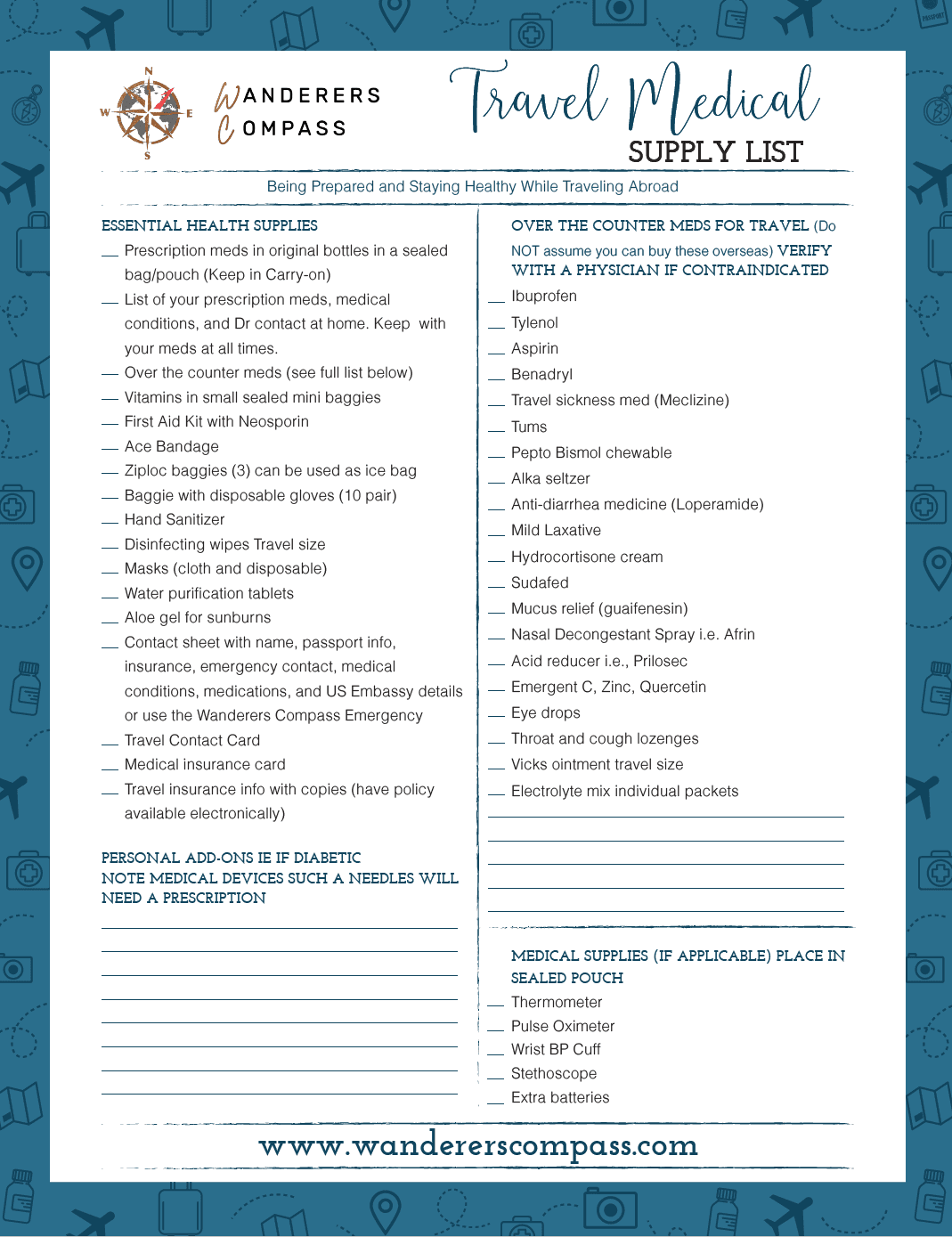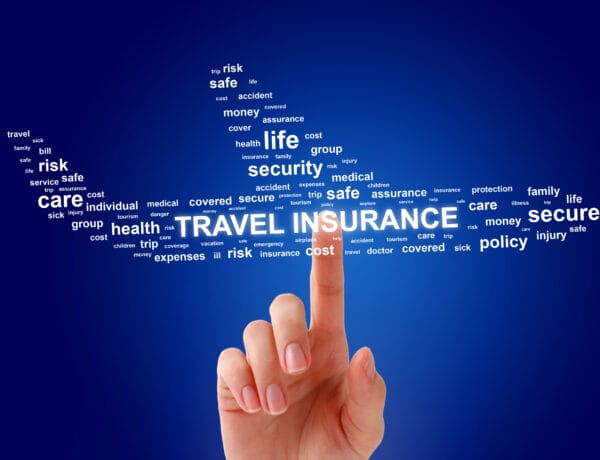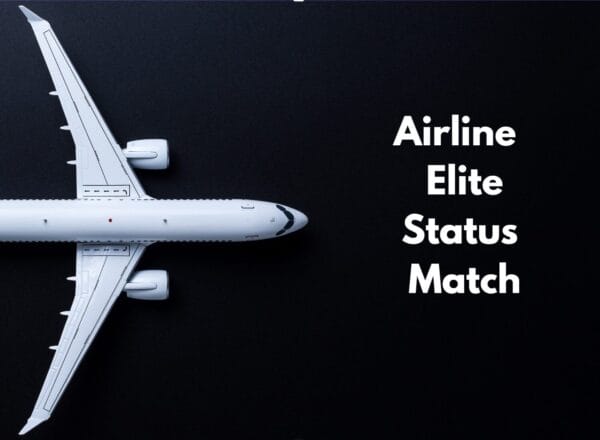
Traveling abroad is always an adventure. It only became possible for most of us due to hard work on multiple levels: money saved for years, sacrificing evenings out and local getaways, hard-earned vacation time from your job, planning, researching, and maybe big projects on hold to visit a destination on your bucket list. These are your dreams, and you are making them a reality; after all, a lot is vested in this.
All that can be done to increase the success of your trip is essential. Life has a funny way of throwing hurdles in our path. By running ourselves down before a trip, we allow health issues an easy way in. As a result, it increases the size of those hurdles. During our trip, we encounter environments we’re not used to, increasing our risk of injury. We eat unfamiliar foods, expose our bodies to new illnesses, and deal with jetlag, dehydration, and fatigue. Despite all that craziness, the joy and life-altering experience you will gain will make it all worth it.
I have been a nurse for too many decades than I wish to admit. It was a profession I am honored to be part of and would do again in a heartbeat. It served me well professionally and in caring for my loved ones and friends. I loved my patients; these amazing people have brought so much to life, more than I ever gave them. In working with my patients over the years, I learned how important it is to give patients knowledge and power, which is gained through education and understanding. That lesson is transferable to taking control of your travel health, too.
I firmly believe knowledge is power, and as a result, it empowers all of us to take control of our health. Therefore, I aim to teach you and guide you on how to stay healthy during travel and what medical supplies you need to address most issues you could face. I will review the items, how they work, and why they are important. As we progress, I share stories from my medical travel mishaps and experiences. This is your dream; it deserves everything you can do to make it a beautiful one. Let’s prepare you.
Learning The Hard Way

Before I present and review the list, let’s discuss what you can do in preparation to start your trip with your best foot forward. All the medicines in the world in your travel medical supplies will not do much if you start in bad shape. Sometimes, we put ourselves in more harm in the chaos of our pre-trip madness. I can speak to that on levels. My nature is to have too many irons in the fire, and I move way too fast, which is not so smart since I am naturally clumsy.
My most recent calamity was on our last trip to Croatia. Exactly 20 days before, I made the simplest twist to put a shirt on a pile while putting away laundry. Something popped in my knee, and I was in instant, excruciating pain, completely unable to bear weight on my leg. I had no doubt I was in big trouble. After an MRI, I was diagnosed with a severe tear of the meniscus in my right knee. It was the one joint in my body I never had a single issue with; go figure. I was nervous because I was sure we would have to cancel the trip. Then there was that other side of me, determined not to let it happen. Yep, I am stubborn that way. After the acute phase, I did all I could to push through.
I left on that trip with a knee brace and a cane, returning weeks later in dramatically less pain and without a cane. It is essential to push through; it is best to rise above life’s hurdles so nothing stops you from achieving your dreams. This is one of many mishaps and health issues I have had before travel and a few during trips. I don’t always follow my own advice to get healthier before a trip.
We can adjust our travel style as life’s surprises come at us. However, if we can improve our state of mind and health before we leave, the odds will be in our favor. If we are well-rested, strong, and healthy, whatever the travel Gods throw at us, we will be way better prepared.
Get Healthy, Mind and Body, Before You Go

Here are my top suggestions to get yourself in the best health before your adventure.
- In the months leading up to your trip, start increasing your daily walking. Try to include hills and uneven surfaces. Strengthen those legs and feet. Wear the shoes you will take on the trip to break them in. Include stretches before and after walking to make your body more limber and improve your balance.
- Drink plenty of water daily and add fresh lemon juice to help with detoxification. If you take supplements, be sure not to miss any days to help your body reach its optimal condition and, most importantly, strengthen your immune system. I start about one month before my travels.
- Start packing early, 3-4 weeks in advance, so you aren’t rushing or stressed at the last minute trying to get everything together. Check out our Packing Tips page on that topic.
- Get lots of rest the week before your trip. I know this is easier to say than done, but do your best. Some people believe you can start setting your body to the new clock. I am not on that boat, but if it works for you, go for it. Our jet lag prevention routine works so well for us that we don’t need to add a long-term intervention.
- Eat a healthy, balanced diet; this is not the time for heavy fried food, lots of carbs, and sugar-heavy desserts.
- Treat yourself to a massage, pedicure, manicure, facial, or all of the above. Much of this you can do yourself if you want to save funds. Maintaining skin health and relaxed muscles promotes a healthy body and mind. It is essential to care for yourself; you deserve it!
- Get a haircut or fresh color so you look as good as you feel.
Our Ultimate Travel Medical Supply List
I developed our travel medical supply list to make this gathering process easier for you. There are numerous products with various names. It can be confusing even in the medical profession. I will simplify what you need and why it is on the list. If you understand why, then that is safer for you and your travel companions.
Only one person in your travel team will need to assemble the travel medical supplies kit, as each person should then carry their prescription medications. Space and weight are limited; we must make the best use of the available space.
The list is a PDF that can print in black and white and color. It is also downloadable to your computer. Click on the image below.
Check With Your Physician
The info given here is general and publicly available. That said, we are each unique beings; what is okay for one person can be risky for another. Any medications on this list, even those that are over-the-counter, should be discussed with your physician. If you wonder why, here are a few examples:
- You have kidney disease or maybe even had a kidney removed to donate to a family member. Your kidneys are now compromised; therefore, you need extra protection. The over-the-counter medication Ibuprofen, also known as Motrin, passes through the kidneys and often contradicts these medical conditions.
- Should you have a history of liver compromise or chronic liver disease, a physician may advise you to avoid Tylenol as your liver processes it.
- If you have GI issues, especially if you are prone to bleeding or on a blood thinner, aspirin and Ibuprofen would be contraindicated. They reduce the ability to clot and increase the risk of bleeding. That is not a significant issue for the average person, but it can be a problem for some individuals with conditions like ulcers.
In the current medical environment, we have made it very easy to ask our medical providers questions. It is often just an email away. An in-person visit is often not necessary or warranted. When in doubt, ask. They are your health care provider and are there to serve you and keep you healthy.
Let’s Start Working Through The List
Travel Medical Supply list pdf
The attached Medical travel supply list is divided into three categories. Essential health supplies, over-the-counter meds, and a medical supply add-on if needed. I will go through each category. The list is a one-page PDF and is printable and downloadable. There are also two sections of blank lines. Based on your health situation, you may have specific items that you need to bring with you. Do you have diabetes? Your blood glucose monitor, syringes, needles, and alcohol wipes can go on these lines. If you have sleep apnea, it could be due to your CPAP machine and its supplies. It would be silly to have two medical supply lists, so we gave you space on ours.
Prescription Medication
Tips for Prescription Meds
There is some strong guidance here that I can not emphasize enough. Whether flying domestically or internationally, the prescription medications you carry with you must be in their original bottles. That bottle should have your name, the physician’s name, the name of the drug, and the dose. It should match the name on your passport.
You should have a list from your physician detailing the medications, their doses, and the reasons you are taking them to be cautious. Though I have never been asked at customs, I know some people who have. With most medical systems now using electronic medical records, you should be able to download this list from your online record without having to request anything from the doctor.
As stated above, prescriptions must be in the original packaging in which they were dispensed to you. There are several good reasons for these safeguards.
- When not in a pill container, they are not secure and get into the hands of children.
- If you were to get ill overseas, the physicians there would want to see those prescription bottles. Some of our medicines in the US may not be available in that country. A pharmacist with the original bottle can figure that out and find a safe alternative.
- In most countries, it is illegal to have prescription meds not in their labeled containers. If not properly packaged, these medications could be confiscated by customs.
- If you become ill and require assistance in taking your meds during a trip, each medication needs to be clearly labeled. The people assisting you need to verify they are giving the correct medication and dose.
- Authorities can charge you with a crime if you have narcotics in a non-prescription container that does not match your name. Therefore, narcotics must stay in their original container.
Bring Extra Days of Your Prescription Meds
There is a hard and fast rule to follow: bring more prescription medications than the length of your trip. At times, events can occur that are out of your control; for example, you could get ill or injured, or there could be a natural disaster at either end of your travels that delays your departure. Many people were stranded without flights home or on cruise ships, with their medications running out during the COVID-19 pandemic. Be prudent and bring at least twice the number of days of medication on the trip. Remember that this is not the US, where you can FedEx pills overnight. Anything that goes international must go through customs, and prescription medications are subject to strict restrictions.
As noted above, it is in your best interest to have a list of your medications, including their doses, reasons for taking each medication, your medical conditions, and your physician’s name with contact information in your travel medical supplies. This list should remain in the same container where you store your prescription medications.
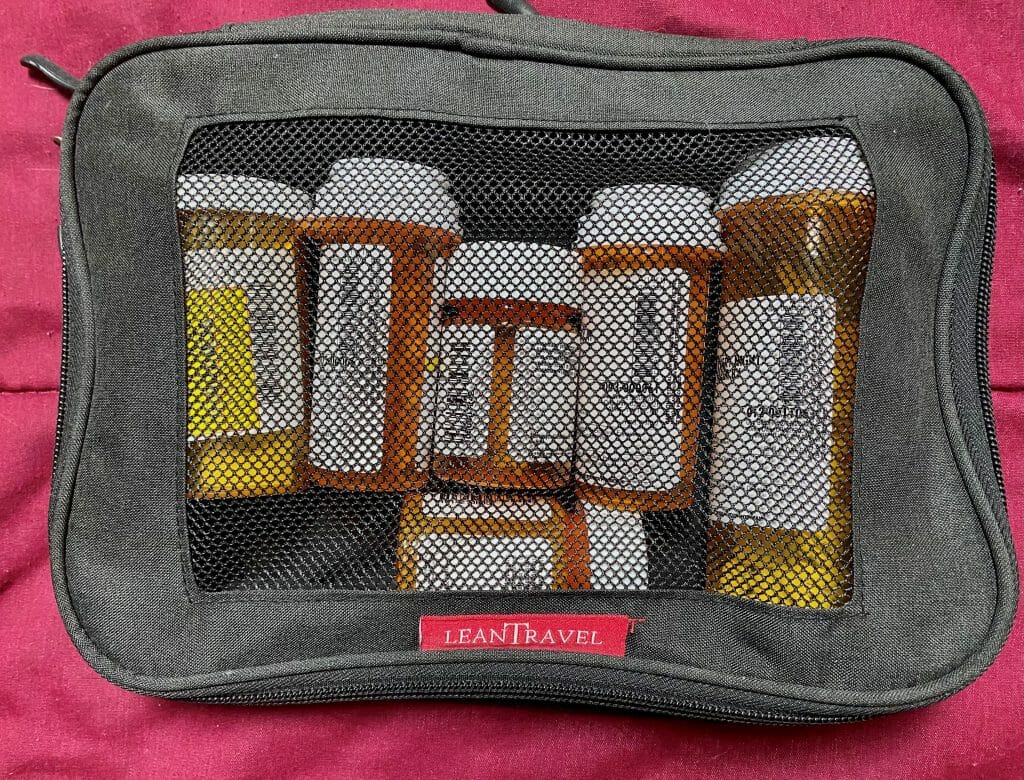
Always store your medications in an airtight container. I use either a packing cube or a mesh bag. Ideally, the container should be relatively straightforward so the contents can be easily visible to people who may be inspecting your bags. Large Ziploc bags work, too, but I prefer something a bit more secure with a zipper.
Keep in mind that medications are not the only thing you need prescriptions for. Some devices, such as needles for injection, glucose monitors, and insulin pumps, also need prescriptions. It would be ideal to carry your prescriptions with you, or these items could be confiscated.
Over-the-counter meds
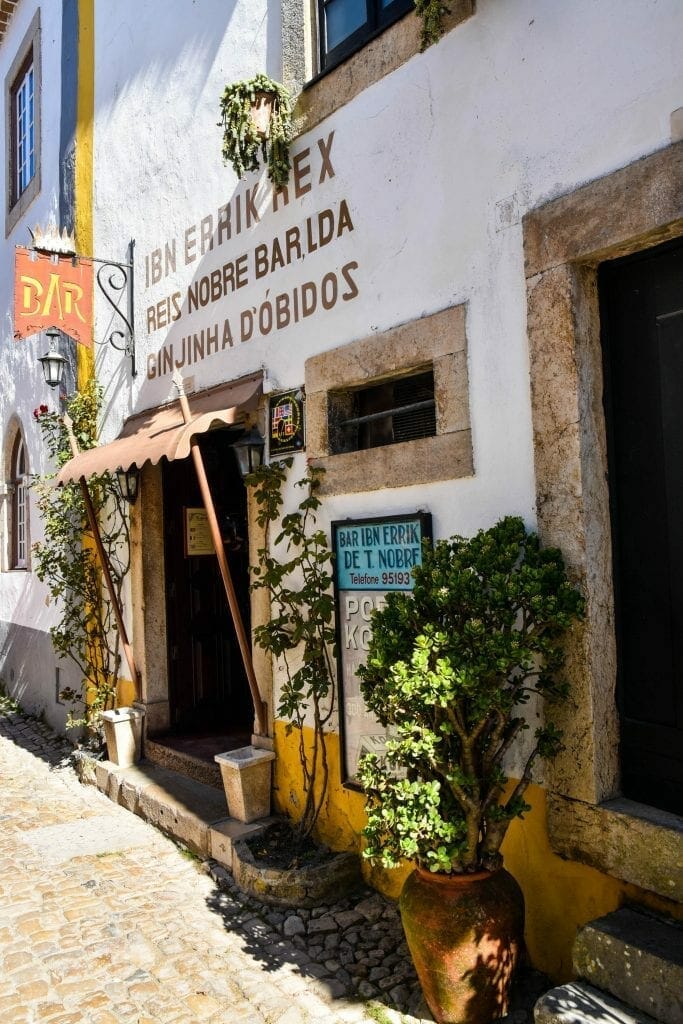
Staying healthy during travel involves being ready for illness and injuries. For serious events, of course, you seek medical care. Most of the time, it is likely something you would typically handle on your own. That is now possible with the items in your travel medical supplies. However, if you are one of those people who say, ‘Well, if I need anything, I will buy it there,’ you may be in for a shock. There are many reasons why:
- In Europe, it is rare to find stores open 24 hours a day, unlike in the United States. In rural communities, you will likely see most shops closed early Saturday and possibly not open until Monday. Even in cities, it is hard to find a Pharmacy open in the evening. If you get ill on Saturday, you may have a long wait before you can get your medication.
- Let’s say you get a horrible head cold and usually take Nyquil, Sudafed, or Benadryl. All are easily accessible in the States. In some places in Europe, however, all of those would need prescriptions. This was the case in Norway when my husband and I visited in early 2020. We had both developed colds and were taking lots of medicines for our symptoms. I had various cold medicines packed, but the supplies were dwindling, with both of us sick.
We checked at every pharmacy in several areas of Norway, and the bottom line was that we could not get those meds. I never ran out, but we would have been miserable if we had. Please do not assume you can get them there. Some countries have meds that are prescribed here, and the pharmacist can dispense them at their discretion. But unless you know for sure, don’t take the risk. Additionally, the medications they have there are not available in the United States. You don’t know if they are contraindicated for your health or interact with your prescription meds. - We mention colds, but gastrointestinal issues can also affect you when traveling. You are eating food you aren’t used to and are exposed to food-borne illnesses your body is unfamiliar with. Sadly, I have had severe food poisoning on a couple of trips. I wasn’t even sure where I got it, as I had eaten nothing unusual or unique in the days leading up to it. Getting through those 24-48 hours can be misery without the right meds.
- Then there are rashes, burns, skin infections, bad cuts, blisters, mild strains, sprains, falls with bruising, and allergic reactions. All these issues can be easily addressed when you have the necessary medication and supplies in your travel medical kit.
- By being ready at the first sign of symptoms, you may be able to stave off more serious illnesses.
What Over-The-Counter Meds Should You Bring
I have provided a list of the medications on the travel medical supply list you should carry with you when traveling, especially overseas. Most of these items are on the CDC’s list of what you should travel with to stay healthy. I will review each medication on the list to help you understand its purpose. The entire list I provided would easily fit in a gallon Ziplock bag. My collection takes up less space as I condense some meds into the same container.
WARNING: Please verify with your physician that none of these meds are contraindicated with your current prescription or for your medical conditions. Don’t assume.
How Pack OTC Meds
Ibuprofen
Ibuprofen, also known as Motrin, is an NSAID anti-inflammatory that reduces fever and pain. It is available over the counter at 200 mg every 4-6 hours. The prescription strength is higher; please consult with your physician to determine the appropriate dose for you. Ibuprofen can be found in some combinations of cold and flu medicines; verify the active ingredient list before taking it.
Tylenol
Acetaminophen, also known as Tylenol, is a medication used to relieve pain and reduce fever. Its over-the-counter strength is 650 to 1000 mg every 4 hours. There is no prescription strength. No matter the circumstances, the maximum dose is 1000 mg every 4 hours. Many cold and flu medicines, as well as some prescription narcotics, contain acetaminophen, also known as Tylenol. Always look at the ingredient list to ensure you don’t double up. This drug can be toxic to the liver if not taken as directed.
Aspirin
Aspirin, also known as Bayer, is a pain reliever, fever reducer, and anti-inflammatory. It can also be used as a blood thinner. It is part of the NSAID family. The standard dose is 650 mg every 4 hours. There is no prescription dose for its over-the-counter uses. Historically, I don’t usually take aspirin, but the current recommendation is that if someone feels chest pain that could be a heart attack, take one aspirin immediately, and call 911. I always have some in my travel medical supply. It should never be taken simultaneously with another NSAID unless in a situation like sudden chest pain.
Benadryl
Diphenhydramine HCl, also known as Benadryl, is an antihistamine. As our bodies develop an allergic response, they release histamine; Benadryl competes with the histamine at the cellular level. Therefore, Benadryl is used for allergic reactions, runny noses, itching, and sneezing. It is an interesting medication with numerous applications. Benadryl can also be useful as a sleep aid for cough, nausea, and allergic rashes. It does cause drowsiness, so it is best to use it at bedtime. The adult over-the-counter dose is 25-50 mg. The prescription dose is the same.
A valuable tip: Everyone should always carry this medication with them. Allergic reactions can occur at any time with no warning. Until medical help can arrive, getting this into someone can mean the difference between life and death.
Meclizine
My Seasickness Story
Meclizine, also known as Antivert, is an antihistamine. It prevents and treats nausea, vomiting, vertigo, and dizziness associated with motion sickness. This drug is comparable to Dramamine but preferable as it causes less drowsiness. It is also longer-acting than Dramamine. The recommended over-the-counter dose is 25-50 mg, taken before travel and every 24 hours thereafter. There are different prescription strengths based on the diagnosis. I will never travel without this med. See the sidebar about my experience with meclizine and seasickness.
Stomach Meds
Tums, Pepto Bismol, Alka Seltzer, and Prilosec. I pack these varied stomach medications, each with its purpose, but some work better in certain situations than others. For that mild acid stomach when I haven’t eaten, Tums serve that well. Pepto Bismol is for mild upset stomach, nausea, or diarrhea. Alka-Seltzer is for when you overeat and have indigestion. That can happen a lot on a European trip! Finally, Prilosec is a proton pump inhibitor that decreases the stomach’s acid production, which is often referred to as acid indigestion or GERD. In all of this GI, meds are taken as directed on the box.
Diarrhea Remedy
Loperamide, also known as Imodium, is used to treat sudden diarrhea, including travelers’ diarrhea. It works by slowing down the movement of the gut. Do not leave home without it! Since dosages can vary, take the medication as directed on the label.
Laxatives
Senna, also known as Senokot, is a mild vegetable laxative to treat constipation. It treats short-term and occasional constipation. Take as directed on the box.
A stool softener, such as Colace, is a laxative that can be slightly stronger than Senna.
Cold and Flu Medicines
Cold medicines. I prefer to avoid a combination of flu and severe cold meds. There are so many ingredients that can be taken at different time points when taken individually. Or maybe you only need two of the five that could be in the combo. I will list the ones I bring, but if you prefer the combo, that’s fine. Be very aware of what is in the combo medication you are taking.
Sudafed
Pseudoephedrine HCL, also known as Sudafed, is a nasal decongestant. There are other decongestants, but I prefer this one. It is used for temporary relief of a stuffy nose and sinus pain, as well as for hay fever, allergies, and bronchitis. There are different concentrations, so follow the directions on the box. Sudafed does not have a different prescription level.
Guaifenesin
Guaifenesin is also known as Mucinex or Robitussin Cough Expectorant. This helps loosen congestion in your chest and throat by thinning and loosening your secretions. There are various strengths and longer-acting, slow-release versions available over the counter, so follow the package directions. There is a stronger prescription strength; therefore, ask your doctor what they recommend you take.
Combo Cold and Flu Meds
Suppose you have a favorite severe cold or flu medicine such as Nyquil, DayQuil, or a generic brand. I suggest packing for a few days. Make sure to pack the original box, so you know exactly what all the ingredients and dosages are. Please note that most of these combinations often contain Sudafed (or a similar decongestant), Dextromethorphan, Guaifenesin, Benadryl, Tylenol, and, in some cases, aspirin or Ibuprofen. You must be aware of precisely what is in the combo to NOT double up on these medications. This is especially important with Tylenol.
Nasal Spray for Congestion
Nasal spray, more commonly known as Afrin, is a decongestant. It works by constricting blood vessels in the nasal passages, thereby reducing nasal congestion and stuffiness. Take as directed on the box. I find that it sometimes works better than any medications I take or use in combination with the cold medications above.
Vicks Vaporub
Vicks VapoRub travel size can help clear nasal passages and alleviate coughing. It also has some other great uses for travel, such as serving as a bug repellent. Check it out here.
Cough and throat lozenges
Cough and Throat Lozenges. Pick your favorite brand and always have some with you.
Hydrocortisone Cream
Hydrocortisone cream is a corticosteroid that helps treat redness, swelling, itching, and discomfort associated with various skin conditions. It works by activating natural substances in the skin to reduce swelling, redness, and itching.
Eye drops
Eye drops are used for reducing redness and moisturizing the eyes. Moisturizing drops are available in single-use containers, making them convenient to bring and easily portable.
Electrolyte Mix
Electrolyte mixes in individual packages are a nice little addition to your travel medical supplies. They are usual because if you get a nasty GI bug with vomiting and diarrhea, fluid loss can be significant. Combating the electrolytes you lose in the process can help you recover.
Supplements for Colds
Finally, if you are a fan of taking supplements, as I am, I always carry a variety of supplements, including Emergen-C or Airborne, Zinc, Quercetin, and Echinacea. The recommendations for doses can vary significantly. Determine what works best for you.
Vitamins
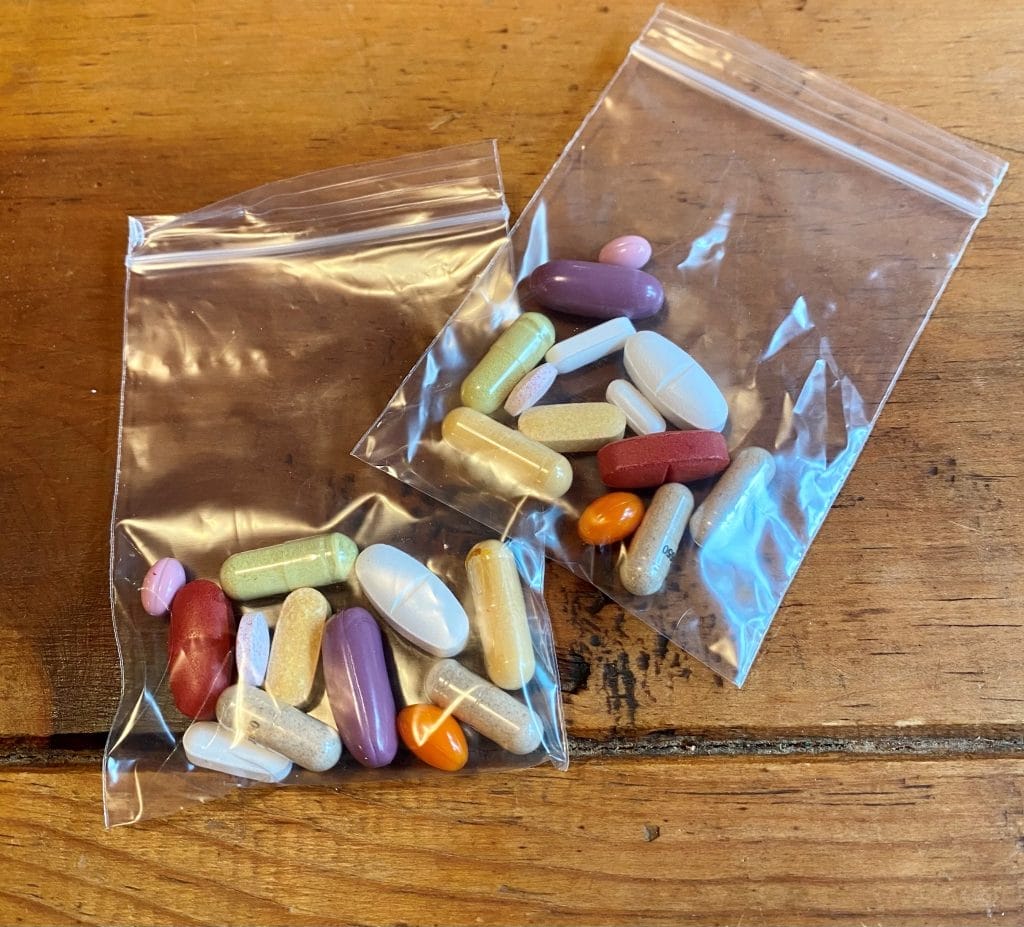
Do you take daily vitamins and supplements? If you do, I have found a great solution to that. On Amazon, I found these great, thicker-quality mini baggies. I make a bag for each day of my trip. It can be a little tedious, but it is worth not having to sort through them daily on the trip. I bring the mini baggie of vitamins to breakfast and take them with my food. If you are into collagen or other powder supplements, these bags will work as well.
Want to learn about Wanderers Compass?
Other Travel Medical Supplies

- First Aid Kit: I bring two on every trip. One goes in my carry-on, and one in my backpack. After looking for years, I have found one I like a lot on Amazon. It contains all the most needed items and also leaves some space to add more. It is also a good idea to add some Neosporin, Betadine ointment, extra gloves, and a mini hand sanitizer.
- Ace Bandage: Mild injuries happen, and often, all you need is something to stabilize the injury. I bring a 3-inch one.
- Ziploc bags: These can serve as ice bags on the trip. I take at least three in my travel medical supplies. I have taken several trips where I left injured, and I knew I would need an ice bag nightly. In those cases, I bring a traditional blue ice bag—a smaller one because in Europe, ice can be quite a commodity.
- Disposable gloves: I always bring a sandwich-sized baggie full of them. Trust me; there may be many times you will want to have gloves!
- Hand Sanitizer: I always include a larger bottle, such as a 3-ounce bottle, in my supplies. This bigger bottle is then used to refill the smaller bottles I take on day trips. I tend to over-sanitize, but that is the nurse in me.
- Water purification tablets: You may be traveling in an area where earthquakes and other natural disasters are a risk. Therefore, you need to be able to drink any water you have access to.
- Sanitizing wipes-Travel size: This is valuable if you need to clean surfaces you may be working on to provide medical care, or items in your hotel room, like phones.
- Masks: Since COVID-19, but even before, they could come in handy if you become ill or are in a situation where you are around many ill people. In Covid times, they are a requirement. I never leave without some. I bring both disposable and cloth masks.
- Aloe Vera Gel-Travel Size: Though I rarely need it when I do, it is gold. Bring a small tube. It will get you by until you can get to a store.
- Essential Medication for Flights: At 35,000 feet, it is the last place you want to be without basic medications. It can make a huge difference in starting the trip on the right foot. Check out our article on Essential Medications for Long Flights: A Nurse’s Guide.
Medical Documents
A huge part of preparing is having the necessary information with you at all times to seek help. This critical info should always be at your fingertips at all times. Not just for yourself, but also for your travel companion. You can make your own with an index card. It should include the following info:
- Full name
- Home Country
- Passport number
- Medications
- Medical Conditions
- Emergency Contacts at home
- Travel insurance company with policy number, website, and contact number
- Health insurance info with policy number, website, and contact number
- US Embassy info and contact number
- Phone info to dial in and out of the country
- Emergency numbers for medical and police emergencies
We are developing a Wanderers Compass Travel Emergency Contact Card, which will be released shortly for our subscribers. It will contain all this information on one wallet-sized card. We carry one of each member of our travel group.
Want to know what medical supplies are best to bring when traveling? Check out our Medical Supply Shopping List for Travel
Blank Space For Your Travel Medical Supplies
Space was left in both columns on our checklists so you can add what items are essential to you. If you have diabetes, you can store your supplies here. If you have a diagnosis of severe asthma or allergies, your inhaler and EpiPen can be added to the list; if you regularly use over-the-counter medications, they can be included as well.
Optional Suggestions-Medical Kit
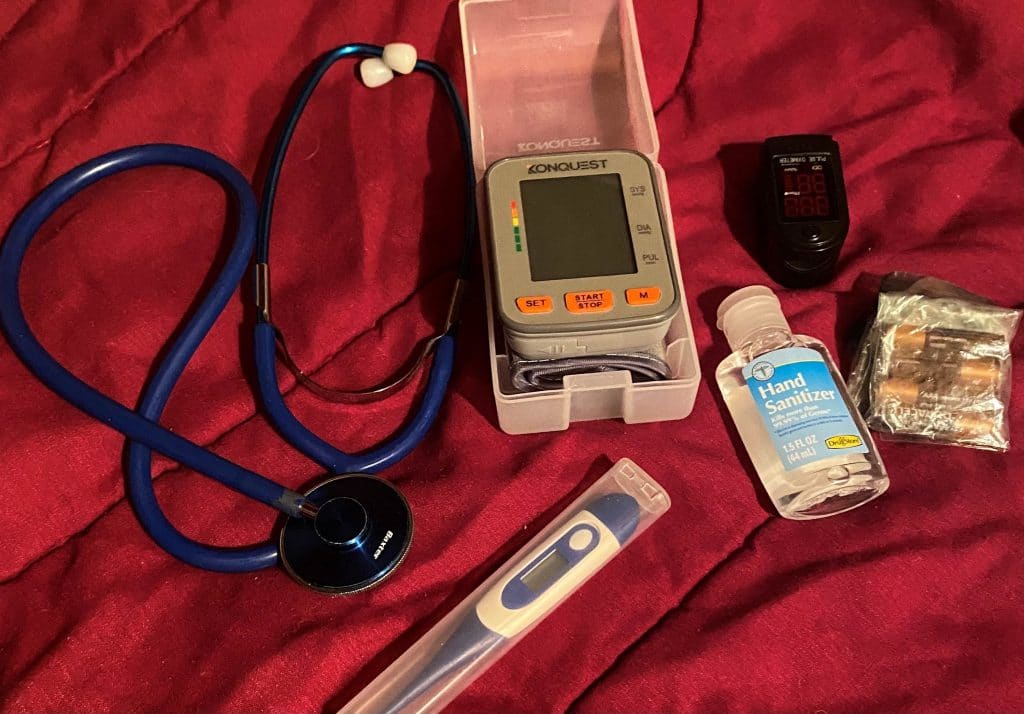
Sticking with the motto of always being prepared, I always bring a small medical device set in my travel medical supplies. I will address each item and explain why I bring it up.
I keep these items in a black mesh bag. They don’t take up much room and weigh little. Having them not just for myself and my travel companions but also for others, if I am called to help, gives me peace of mind.
Is there anyone on this flight who is a doctor, nurse, or EMT…?
Thermometer Oral digital
It’s pretty darn self-explanatory. Because if you have a fever, you should know. If it is severe, you can seek medical care more quickly and report your temperature readings.
Pulse Oximeter
This is a small device that attaches to your finger and measures your blood oxygen level. It also reads your heart rate, and some new models can detect irregular rates. During the COVID days, they became highly coveted items and were hard to obtain. If you develop a respiratory issue, the biggest question is whether you are getting enough oxygen. This is easy and quick to assess. That data point can help determine if it is warranted to go to the hospital. I am never without one. They can be purchased on Amazon, at most Pharmacies, at Costco, etc. They are relatively inexpensive. Look for ones with a lot of reviews! Take a look at the sidebar to learn why I never travel without one.
Blood Pressure Cuff
Wrist BP cuff. Though elevated BP can affect all ages, it is more of an issue for older populations or people on blood pressure medication. The cuff is lightweight and easy to carry, providing good information if you encounter problems. It also tracks your heart rate.
Stethoscope
It is a helpful tool for people who know how to use it. That can be people who have family members with asthma, COPD, or other respiratory issues. Certain things can only be determined if you can listen. I once used it in an airplane emergency I was assisting with.
Syringes
I like to bring a few syringes without needles. These can have several uses, but they are primarily for the irrigation of wounds. The syringes can measure liquid medicines for children and are also handy for adults who need to administer liquid medications.
Batteries for the Above Items
Two of the above items may need batteries. I always bring two extra sets and keep them in the mesh bag.
Final Thoughts
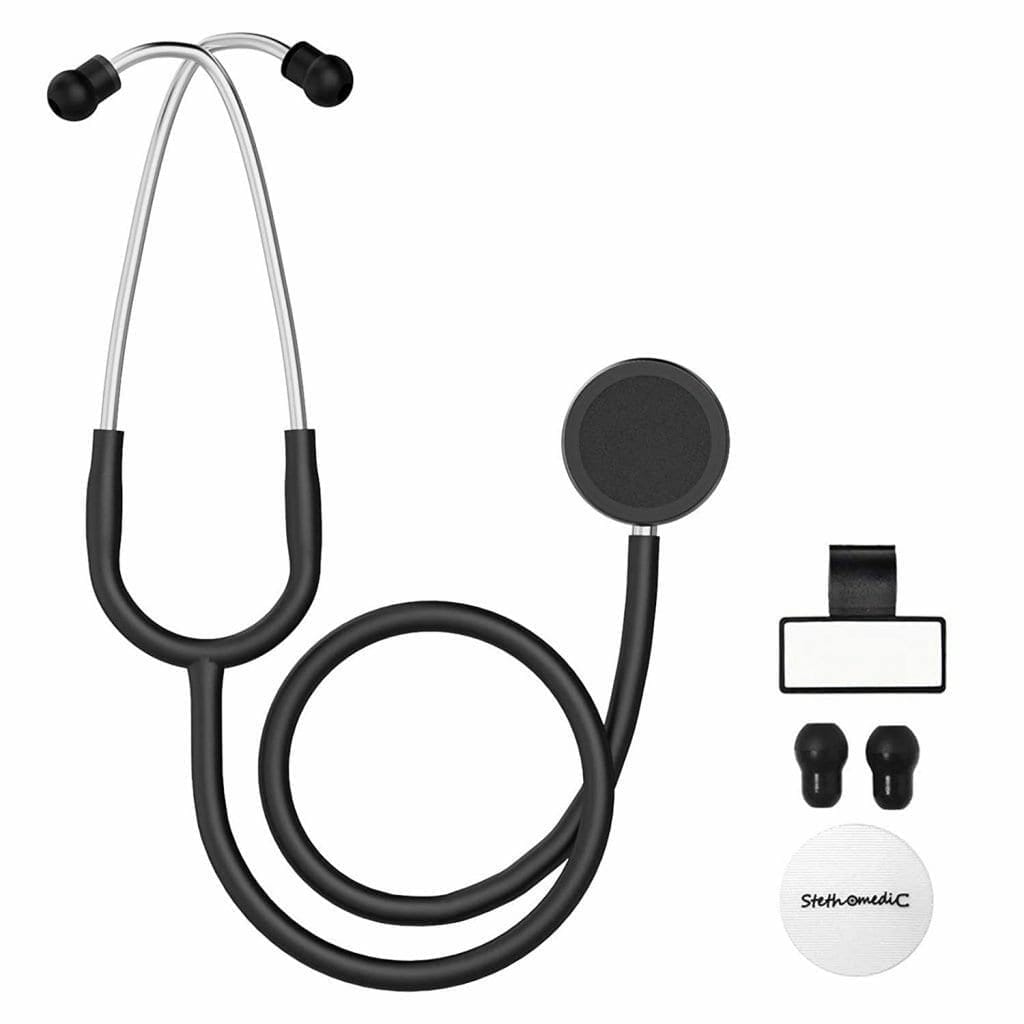
Staying healthy during travel is something you have considerable control over. The travel medical supply list provided here is one way to assist in that goal. It seems like it would take up a lot of room, but I assure you it doesn’t. If it increases your chances of travel success and averts more serious problems, it becomes priceless. The lesson here is that access to and the quality of items you need may not be available to you when you are abroad, so it is essential to bring them with you. I will buy them over there with work clothes or snacks. It is not a good rule when dealing with health issues.
Travel health and safety are about being prepared for the what-ifs. Hopefully, you can avoid more serious illnesses or eliminate the time spent seeking medications or medical care if you are ill. Your health and safety are paramount. This is your dream to travel; keep it as safe and healthy as possible.
Stay well and strong during your adventures!!
© 2025 Wanderers Compass All Rights Reserved
Check out our other Tips and Resources Posts
Essential Medications for Long Flights: What to Bring
Discover essential medications for long flights to ensure a comfortable journey and handle any…
November 25, 2025Winter Gear Checklist: Must-Have Items for Skiing
Avoid common skiing mistakes with our winter gear checklist. Get prepared and make your…
November 24, 2025Travel Insurance – Learn How to Protect Your Trip
Travel insurance can save you from unforeseen expenses. Discover why it is a must-have…
November 23, 2025Seasonal Camping Tips for Every Weather Condition
Ready for year-round adventures? Learn the essentials of seasonal camping and how to thrive…
November 8, 2025Mastering Travel Etiquette: A Guide to Being a Good Traveler
Understand the importance of travel etiquette and how it can elevate your travel experiences…
May 17, 2025Dalida: A Taste of the Mediterranean in San Francisco’s Presidio
Dive into Tokyo’s playful side to see how humor, whimsy, and imagination are just…
May 17, 2025Travel Brand Loyalty: Why It Matters in Travel
Understand Travel Brand Loyalty and its benefits, including exceptional experiences and feeling valued as…
May 3, 2025Airline Elite Status Match: A Travel Hack
used my Alaska Airlines MVP status to match into United Gold, and within one…
April 21, 2025Easter Island: Beyond the Moai
Discover the magic of Easter Island in our latest feature for Food, Wine, and…
April 3, 2025Our Top Recommended Travel Products
Travel Insurance
Squaremouth.com
Our favorite travel insurance site!
We strongly advocate for comprehensive travel insurance, not only for minor inconveniences but also for major, unexpected events like medical emergencies. We never leave home without it. Our go-to resource is Squaremouth.com. which offers a user-friendly platform that connects you with top-rated, reputable insurance carriers. Plus, they’ll mediate on your behalf if you run into any issues.
To empower you as a consumer, we recommend you read our blog post on why travel insurance is essential and how to secure the best coverage from leading companies at an affordable price.
MedjetAssist
Medical transport back home from anywhere in the world
Medjet is a leading provider of global air medical transport. Unlike traditional travel insurance, which typically covers medical evacuation to the nearest facility, Medjet goes further by ensuring you’re transported back to the U.S. to the hospital of your choice once you’re stable enough to fly. Medjet offers membership plans that focus on medical transport, while Medjet Horizon provides expanded coverage for broader protection. Individual trip policies start at just $99, and annual policies are available for around $300. Most policies have an age limit of 74.
To learn more about how Medical Evacuation membership with Medjet Assist works, check out our blog post for a more detailed review.
Accommodations and Airfare
Booking.com
Hotels, Home rentals, BNBs, Flights, and other Transportation & Tours
Booking.com connects millions of travelers to unforgettable experiences, a wide range of transportation options, and incredible places to stay—from homes to hotels and beyond. As one of the world’s largest travel marketplaces, it supports well-known brands and entrepreneurs of all sizes. For its convenience, variety, and reliability, it’s our preferred booking platform.
Expedia and VRBO
Hotels, home rentals, BNBs, flights, and other transportation & tours
Expedia is a U.S.-based company with a mission to make global travel accessible to everyone, everywhere. At Wanderers Compass, we embrace independent travel, and platforms like Expedia are essential to making that a reality. Expedia allows you to book every aspect of your trip—from flights and accommodations to rental cars, cruises, and activities—making it a one-stop shop for all your travel needs.
Transportation
Daytrip
Personalized city-to-city private car transfer service
Daytrip provides an affordable private car service for city-to-city transfers worldwide, and we absolutely love their service. It’s a cost-effective alternative to renting a car, providing comfortable, stress-free travel with the bonus of scenic stops along the way. For example, we used Daytrip for travel between Budapest and Vienna, enjoying some fantastic detours to local attractions. With professional drivers and customizable routes, Daytrip ensures a smooth ride while allowing you to explore hidden gems and unique sights along your journey.
To learn more about how Daytrip, check out our blog post for a more detailed review.
Travel Experiences
Viator
The leading marketplace for travel experiences
Viator believes that travel is all about creating unforgettable memories. With over 300,000 experiences to choose from—ranging from simple tours to extreme adventures, plus a wide array of unique, niche activities—it’s never been easier to make lasting memories. We frequently use Viator during our travels and especially appreciate their flexible cancellation policy, which adds peace of mind to every booking.
Communication products for seamless connectivity overseas
GigSky International eSIM Data Plans
Local Prices. No Roaming. Fastest Networks.
GigSky eSIM effortlessly connects travelers around the globe, eliminating the need to swap physical SIM cards or deal with surprise roaming charges. With affordable data plans and instant activation, you can enjoy reliable internet access in over 190 countries, making your travel experience more convenient than ever. Plus, they offer a fantastic deal: a free 100 MB data plan with no credit card required. They are so confident that you will love their service!
Enjoy 10% off all GigSky Plans (except cruise and inflight) with our discount code WCOMPASS10.
To learn more about how GigSky works, check out our blog post for a more detailed review.
Shopping
Wanderers Compass Amazon Storefront
An excellent source for all travel essentials and guides that we have vetted ourselves
Amazon is one of the world’s most comprehensive online shopping platforms, offering lower prices, a wide selection, and fast delivery through teams worldwide.
This page contains affiliate links. When you purchase through these links, we may earn a small commission at no extra cost to you. Thank you for your ongoing support!


